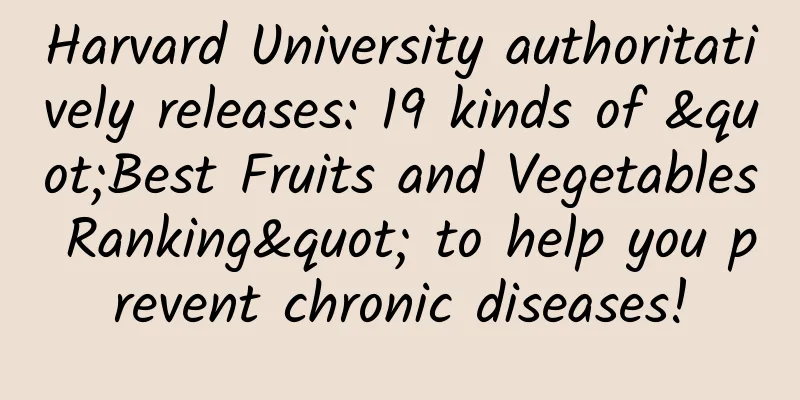Harvard University authoritatively releases: 19 kinds of "Best Fruits and Vegetables Ranking" to help you prevent chronic diseases!

|
Hello everyone, today we are going to talk about a very important topic - how to reduce the risk of chronic diseases by choosing healthy fruits and vegetables. Recently, a study from Harvard University has provided us with a new perspective, let's take a look! First, we need to understand a new concept - " high metabolic quality fruits and vegetables ". Simply put, these fruits and vegetables are not only colorful and rich in phytonutrients, but also have a certain relationship with the reduction of chronic disease risks. Researchers at Harvard University analyzed data from 42,000 people and found that different types of fruits and vegetables have significant differences in their effectiveness in preventing chronic diseases. High metabolic quality fruits and vegetables ranking For the study, the researchers grouped the biomarkers into five categories: insulin /glucose, inflammation, endothelial function, adipokines, and lipids. Here are the top 19 fruits and vegetables with high metabolic quality: Apple/Pear (5 points) Romaine lettuce (4 points) Spinach (4 points) Alfalfa sprouts (4 points) Eggplant/zucchini (4 points) Raisins/Grapes (4 points) Broccoli (4 points) Celery (4 points) Kale (4 points) Green and red peppers (4 points) Carrots (3 points) Cauliflower (3 points) Romaine lettuce (2 points) Blueberries (2 points) Grapefruit (2 points) Orange (2 points) Prunes (2 points) Mushrooms (2 points) Banana (2 points) Relatively speaking, the five vegetables and fruits with lower metabolic quality are: peas, fried potatoes, watermelon, tomato juice, and corn. How to eat fruits and vegetables to maximize their disease prevention value? 1. Eat enough but also eat right Include vegetables at every meal: Eat no less than 300 grams of vegetables every day. Choose more dark-colored vegetables, such as dark green, red, orange or purple. These vegetables are rich in beta-carotene, a major source of vitamin A. Colorful fruits and vegetables: Choose fruits and vegetables of various colors to ensure the intake of nutrients such as anthocyanins, lutein, chlorophyll, lycopene, carotene, etc.; give priority to local, seasonal fruits and vegetables, which have better flavor and nutrition. Zeqiao original copyright contact 2. How should special groups eat? Overweight, obese and hypertensive patients: It is suitable to eat fruit before meals. Diabetic patients: It is suitable to eat fruit between meals. People with hyperuricemia or gout : Avoid eating foods high in purine, such as asparagus, mushrooms, and beans. People with poor gastrointestinal function: Fruits such as watermelon and pear are cold, so eat less. 3. Vegetable cooking follows 3 principles- Wash first and then cut: Cutting first and then washing will cause some water-soluble vitamins (such as B vitamins, vitamin C) and potassium and polyphenols to be lost with the water. Short-time heating: Use blanching, boiling, rinsing and high-heat stir-frying, especially for leafy vegetables, to shorten the heating time and retain nutrients to the greatest extent. Low-temperature cooking: It is recommended to use cooking methods that use water and steam as heat transfer media, such as steaming, braising, and blanching. Practical recommendations For the top five high metabolic quality fruits and vegetables listed in the study, here are some specific eating recommendations: Apple/Pear: Eat raw with the skin on. People with weak stomachs can steam them before eating. Ball lettuce/Romaine lettuce: eaten raw or served cold. Spinach: It is recommended to blanch it and then stir-fry it. Alfalfa sprouts: can be mixed with fresh walnut kernels or dried tofu and served cold. Eggplant/zucchini: Both can be used as stuffing. Zucchini can also be shredded and served cold or made into salad. Zeqiao original copyright contact Among them, romaine lettuce, spinach, alfalfa sprouts, and zucchini are all high-potassium, low-sodium, and low-calorie vegetables, which are particularly suitable for people with high cholesterol, high blood sugar, and high blood pressure. |
<<: 0 cost! This seemingly "shameful" little habit is really stress-relieving!
Recommend
Menstrual period stomach pain and gas farting
During menstruation, many behavioral habits of gi...
Can I breastfeed while taking clindamycin?
You may have heard of Clindamycin Hydrochloride f...
After Yangkang, will exercise lead to sudden death from myocarditis? How long can I exercise?
Can I resume exercise immediately after “Yang Kan...
What are the dangers of women having leucorrhea?
Women's vaginas often secrete leucorrhea and ...
How to choose the right bra
Women's breasts are a soft and fragile area. ...
What are the basic characteristics of psychology? What does applied psychology study?
In recent issues, we have shared with you some ba...
What are the pros and cons of female masturbation?
Everyone has physiological needs, and now both me...
Is it okay for a woman to be strong in her forties?
Everyone knows that after women and men enter int...
What to do if you always want to urinate during pregnancy
When mothers are pregnant, they often have freque...
What can't I eat if my endometrium is thin?
Thin endometrium is one of the main reasons that ...
Yogurt and strong tea can help sober you up? Doctor: These are not effective for sobering you up. What really works is…
"The deeper the friendship, the better!"...
I always feel thirsty during confinement.
Pregnant women may feel thirsty all the time afte...
What to do if a breastfeeding mother has toothache
Breastfeeding mothers are most afraid of getting ...
How to use baking foil? What are the baked goods?
Baking, also known as roasting, refers to the pro...
What does pregnancy dream mean?
Many pregnant women often have dreams during preg...









